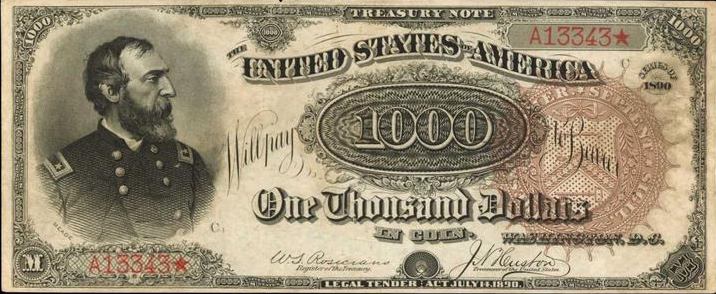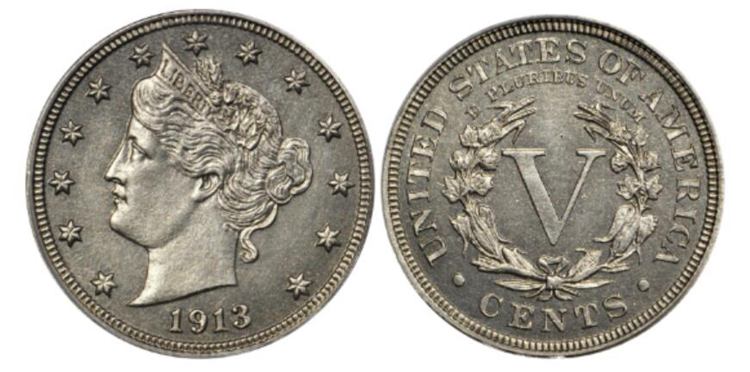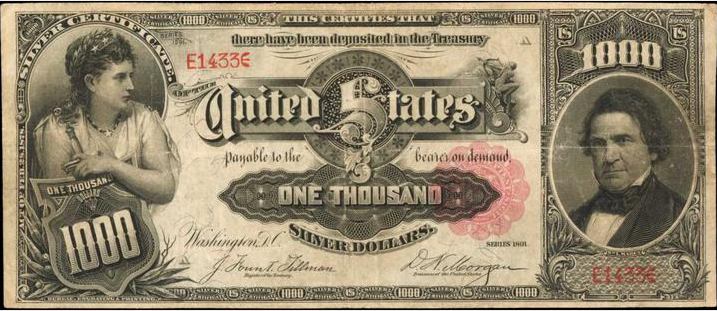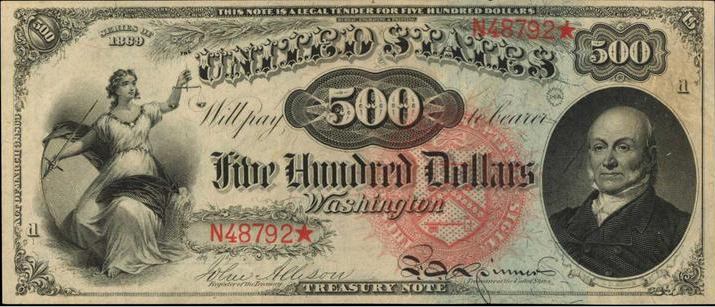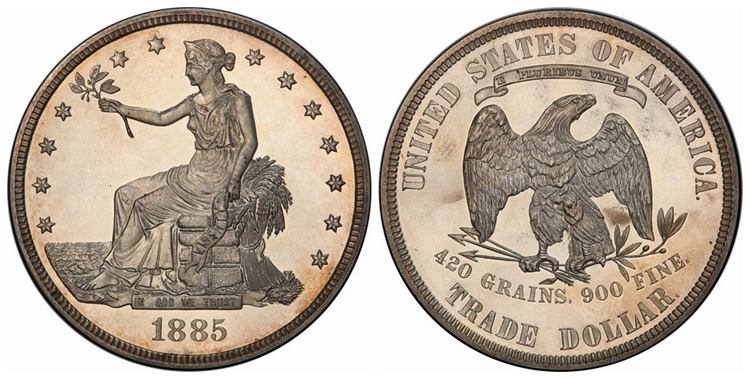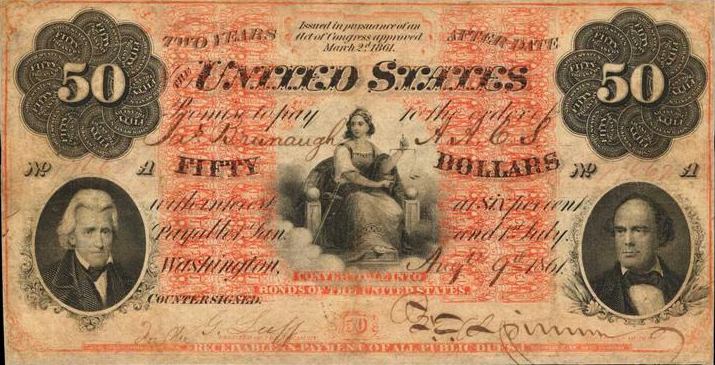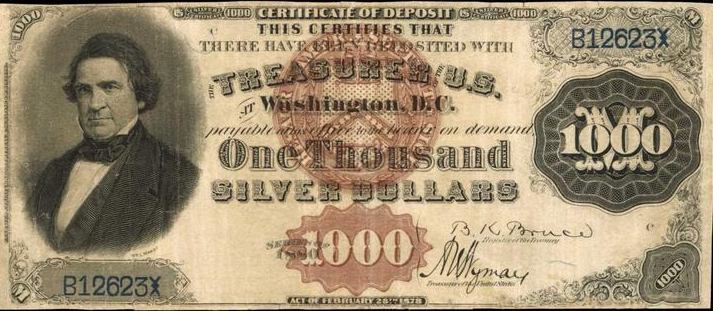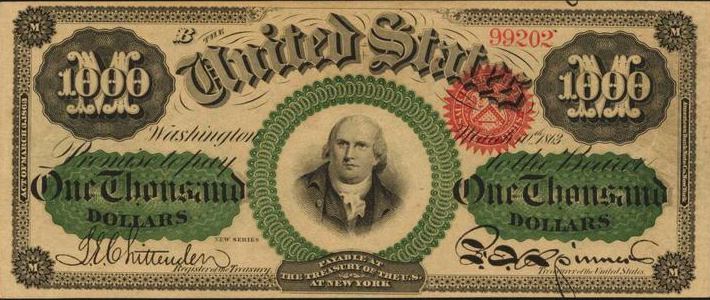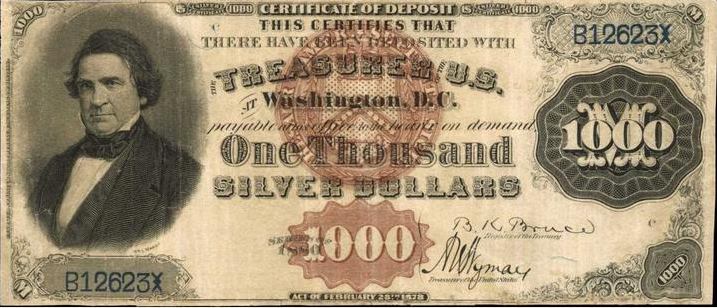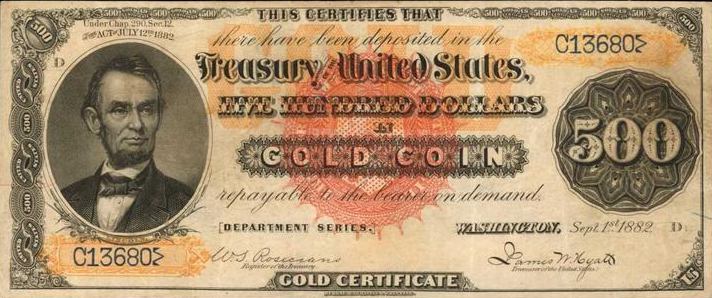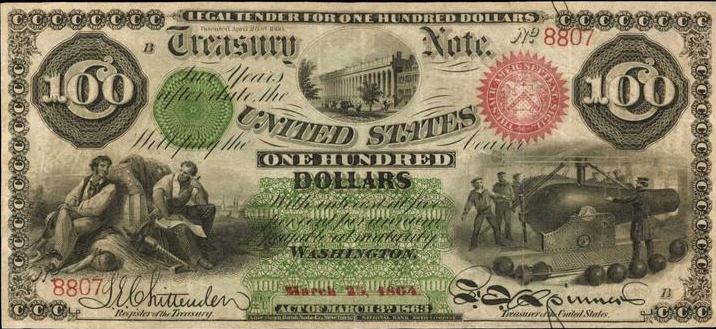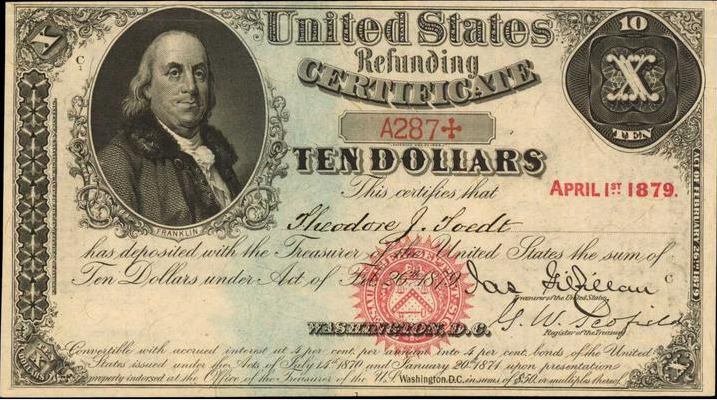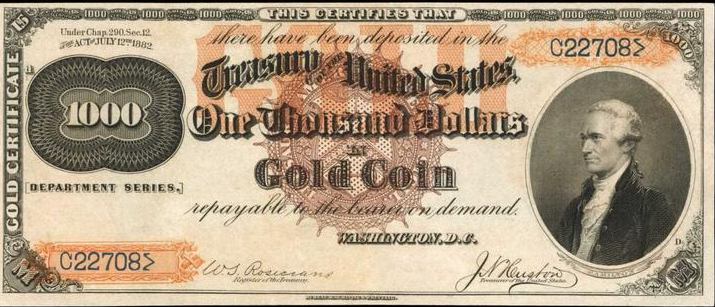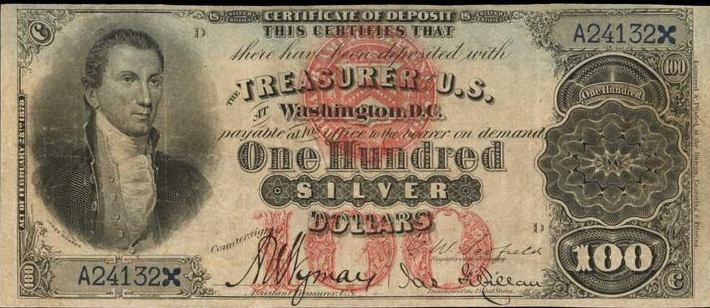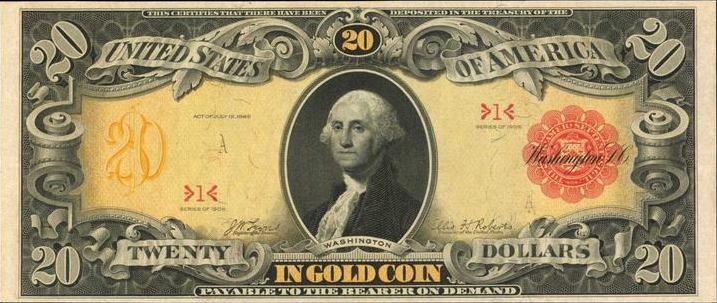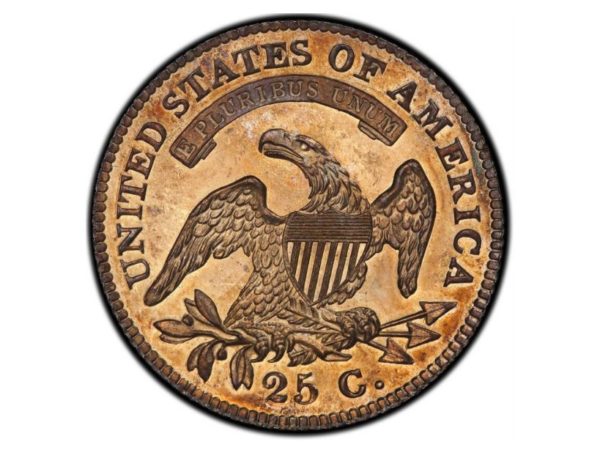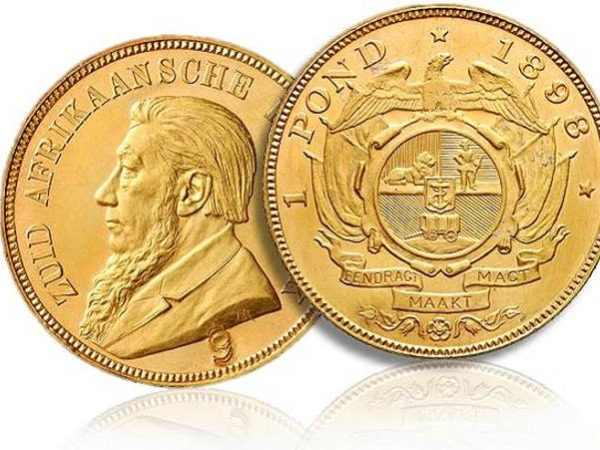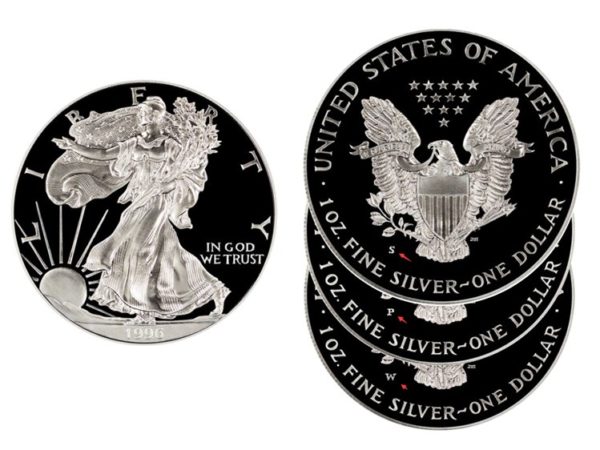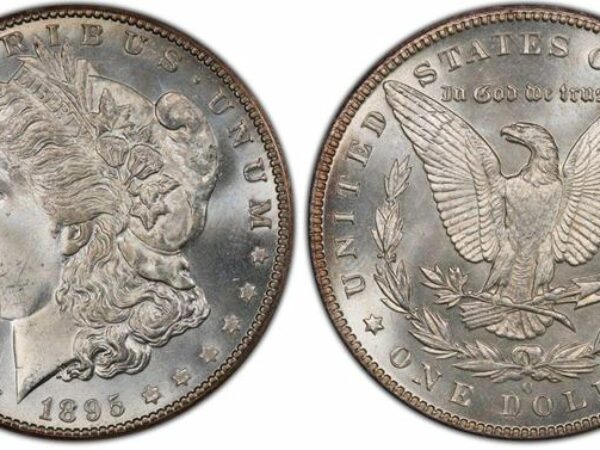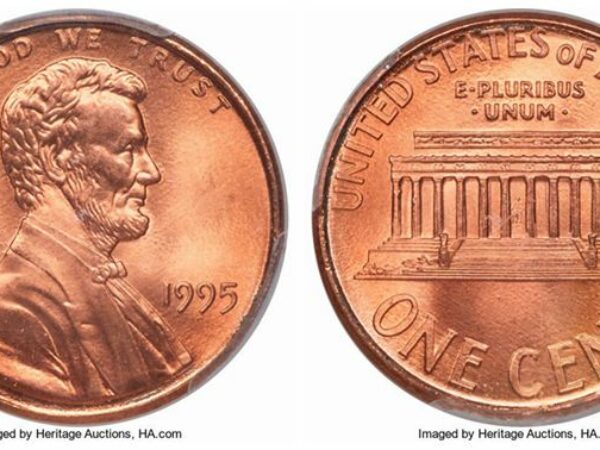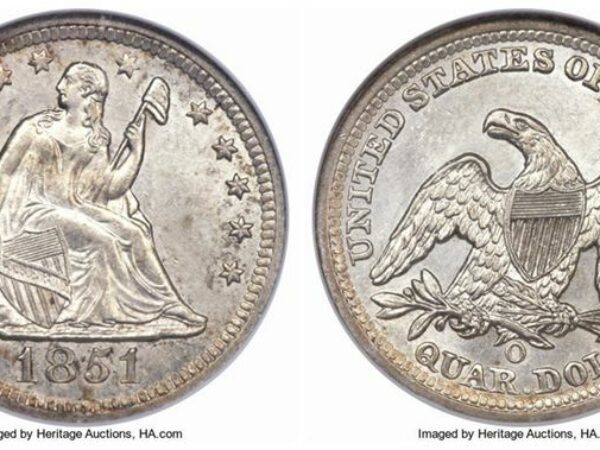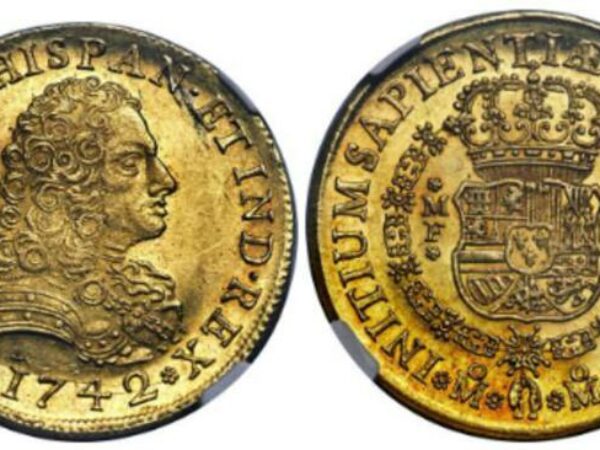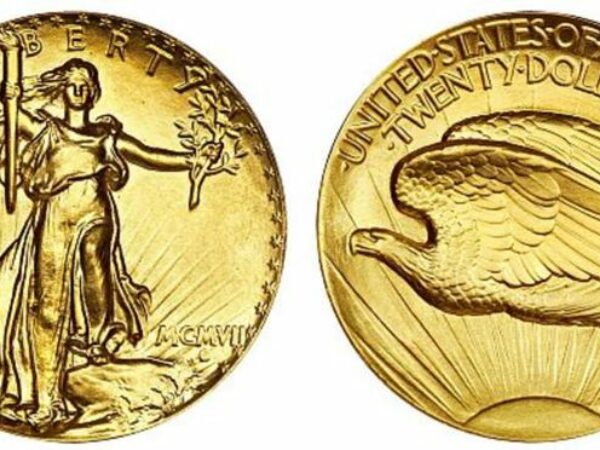You might have heard of a few of these bills, but others may come as a surprise. Did you know that there are old US bills still in existence that are so valuable they could actually buy a house or even a car?
The US dollar has long been a world reserve currency, so it wouldn’t be unreasonable to expect there was some type of rare currency for collectors. But what can you really expect in terms of rarity? Is it possible that some of them are so rare, you probably don’t even hear about them? Keep reading to find out what some of the most valuable money you can buy looks like.
Table of Contents
15 Rarest US Currency: List
No |
Currency |
Grade |
Price |
1 |
1890 $1000 Treasury Note |
About New 50 |
$2,040,000 |
2 |
1913 Liberty Head Nickel |
PR66 |
$4,560,000 |
3 |
1891 $1000 Silver Certificate |
Very Fine 25 |
$1,920,000 |
4 |
1869 $500 Legal Tender Note |
About New 55 |
$1,440,000 |
5 |
1885 Trade Dollar |
PR64 |
$1,320,000 |
6 |
1861 $50 Interest Bearing Note |
Very Fine 25 |
$1,020,000 |
7 |
1880 $1000 Silver Certificate of Deposit |
Very Fine 25 |
$1,020,000 |
8 |
1863 $1000 Legal Tender Note |
About New 58 |
$960,000 |
9 |
1880 $1,000 Legal Tender Note |
About New 55 |
$960,000 |
10 |
1882 $500 Gold Certificate |
Very Fine 35 |
$900,000 |
11 |
1863 $100 Interest Bearing Note |
Very Fine 30 |
$900,000 |
12 |
1879 $10 Refunding Certificate |
About New 58 |
$780,000 |
13 |
1882 $1000 Gold Certificate |
Extremely Fine 45 |
$720,000 |
14 |
1878 $100 Silver Certificate of Deposit |
Very Fine 25 |
$660,000 |
15 |
1905 $20 Gold Certificate |
New 65 |
$552,000 |
1. 1890 $1000 Treasury Note
Price: $2,040,000
Grade: About New 50
Even though the Joel R. Anderson Collection is home to several exceptional and rare notes, this 1890 $1000 Treasury Note may be the one note that has captured the attention of US currency collectors the most. These notes are frequently referred to as “the Grand Watermelon” because of the recognizable huge green zeros on the back of the note that resemble the fruit.
The huge, green zeroes on the reverse of this note are what give it its moniker; they resemble juicy watermelons. Although the Treasury Department did not perceive the Grand Watermelon Note in the same way as we do today, changes were made to the design in 1890.
With the engraved signatures of Treasury officials Rosecrans and Huston and the recognizable huge brown Treasury Seal at right, this sample is the first of its kind. Its lineage may be traced back to people like Amon Carter Jr., James Wade, and F.C.C. Boyd. Of the seven Grand Watermelon notes that are known, this is the best.
2. 1913 Liberty Head Nickel
Price: $4,560,000
Grade: PR66
The only five struck, two of which are in museums, are by far the best. The specimen from the Louis E. Eliasberg, Sr. and Dr. William Morton-Smith Collection. The coin is the only specimen with a surface that sparkles like a mirror. At the rim is a little planchet lamination.
The long-lost, then-rediscovered 1913 Liberty Nickel that was originally owned by George Walton was auctioned off on April 25, 2013, and Jeff Garrett of Lexington, KY, and Larry Lee of Panama City, FL, paid $3,172,500 for it.
The PCGS Condition Census is a list of the example’s complete provenance for PCGS PR63. The fifth specimen, which was previously thought to be lost, was the subject of a $10,000 prize issued in 2003 by Bowers & Merena, a division of Collectors Universe at the time.
Only three of the five remain on the market because two of them have been seized and placed in museum collections. A 1913 Liberty Head Nickel auction is always a significant occasion and frequently sets yet another price record.
3. 1891 $1000 Silver Certificate
Price: $1,920,000
Grade: Very Fine 25
This famous Series of 1891 $1000 Silver Certificate is known by currency experts as the “Marcy Note” due to the portrait of William L. Marcy that can be seen to the right. It is a great American treasure and one of the most unusual notes in all of United States currency. Only two examples of the design type are known to exist, and the piece being sold is the only one in private hands.
The note is from plate A and has the serial number E1433. When it was sold by private treaty for $2.6 million in 2013, this item set the record for the highest price ever paid for a piece of paper money. The Smithsonian Institution’s National Numismatic Collection is home to the other surviving specimen, serial number E1 from plate A, for all time.
One of the highlights of the Joel R. Anderson Collection is this particular note, a rarity for which the collecting community has no other exemplar. Without this notation, no high-level United States-type collection may be said to be finished.
4. 1869 $500 Legal Tender Note
Price: $1,440,000
Grade: About New 55
Although there are many exceptional and unusual notes in the Joel R. Anderson Collection, it is impossible to overestimate the importance of the current note. The only specimen of its kind that is obtainable to collectors is this $500 “Rainbow” Legal Tender Note from 1869.
Justice, an allegorical figure, is shown on the note carrying a sword with an upward-pointing blade in her right hand and balance scales in her left hand. In a lavish die counter in the middle, the denomination is prominently shown. The presidential portrait of John Quincy Adams is displayed in an oval frame to the right. The lower left and upper right of the center include the serial numbers, which are highlighted in red.
Just to the right of the middle, there is a huge pink Treasury Seal. Along the bottom edge of the pattern, Allison and Spinner’s etched autographs can be seen. The Legal Tender clause is enclosed in a circle at the middle of the back, which is elaborately printed in green with huge 500 counters on the left and right.
Only three of the 89,360 copies that were printed still exist. Compared to the $1000 “Grand Watermelon” notes from 1890, which are three times more common in private collections, this note is much uncommon.
5. 1885 Trade Dollar
Price: $1,320,000
Grade: PR64
This famous rarity from the trade dollar series has an antique silver tone that is iridescent on both sides. A few hints of a slightly warmer sandy-rose tinting can be seen, namely in the lower right corner of the reverse and the obverse perimeter. Every one of the eagle’s feathers is clearly defined on that side of the coin, which is entirely struck with fine detail from the rim to the center.
One of the finest American numismatic classics is the 1885 trade dollar, which is ranked 15th in Jeff Garrett and Ron Guth’s well-known and influential book 100 Greatest U.S. Coins (5th Edition, 2019).
The 1885 trade dollar is around three times rarer than the 1804 dollar (15 known), is tied with the 1913 Liberty Head nickel (five known), and is almost on par with the 1822 half eagle in terms of rarity (three known).
It is noteworthy that neither the American Numismatic Society nor the Smithsonian Institution, owners of two of the best collections of American coins ever assembled, have an 1884 or an 1885 commerce dollar. The American Numismatic Association doesn’t have one either.
6. 1861 $50 Interest Bearing Note
Price: $1,020,000
Grade: Very Fine 25
The only issued specimen of the whole series of 1861 Interest Bearing Notes still in private hands is this exceedingly significant offering. Among his numerous treasures, this is one of Joel Anderson’s favorite notes.
The series was produced in accordance with a law approved by Congress on March 2nd, 1861, which called for the issuance of $10 million in bonds or, in the event that bonds could not be sold, circulating interest bearing notes with a minimum face value of $50 and an annual interest rate of 6%.
Interest Bearing Notes in the amounts of $50, $100, $500, and $1000 were issued since the Civil War was imminent and there was no market demand for bonds. They were created using a method called “cycloidal configurations” by the National Bank Note Company.
For the whole 1861 issuance of Interest Bearing Notes, this is the only collectible issued note that is still in existence. The Bureau of Public Debt in Washington, D.C., has another $50 note that has been redeemed and canceled. The only additional notes for this series that are known to exist are in proof or specimen form.
7. 1880 $1000 Silver Certificate of Deposit
Price: $1,020,000
Grade: Very Fine 25
One of just two instances of the type that are in private hands, this 1880 $1000 Silver Certificate is a noteworthy highlight from the impressive Joel R. Anderson Collection. The bold presentation of the printed design elements and the retention of vibrant color in the brown and blue overprints. The paper maintains its beautiful, creamy white color and has modest, grade-appropriate circulation.
Only five of the 8,000 Bruce-Wyman $1000 notes issued in 1880 are known to still exist. One of these notes is housed in the Smithsonian, and the other two are kept in institutional collections by the Federal Reserve Banks of Chicago and San Francisco. No notes signed by Bruce-Gilfillan are known to have survived.
The Amon Carter specimen, rated Very Fine, is the only other privately owned example of this type. That note has never been presented to the public.
Only two 1880 “Black Back” Silver Certificate type sets are available to build due to the scarcity of the $500 and $1000 denominations of this series. When the current note was sold at auction in October 2005, it last brought approximately $667,000. Any serious collector of large-size federal paper money should not pass up this chance because it is incredibly rare.
8. 1863 $1000 Legal Tender Note
Price: $960,000
Grade: About New 58
This is not just one of the most impressive pieces in the Joel R. Anderson Collection, but it is also a priceless piece of American numismatic history. There are only two $1000 Legal Tender Notes with dates of 1862 and 1863 that are known to collectors, and this one is the best graded of the four.
The note has generous margins, and the only flaw preventing it from receiving a complete Uncirculated grade is a single barely perceptible corner fold at the bottom left. Robert Morris, a founding father and former superintendent of finance, is depicted in the center of the unusual face design.
The majority of these big-denomination notes were not carried by the general people but rather used in huge exchanges and bank-to-bank transactions.
9. 1880 $1,000 Legal Tender Note
Price: $960,000
Grade: About New 55
Even the most knowledgeable experts on US currency can undoubtedly recognize this 1880 $1000 Legal Tender Note with its huge brown spiky Treasury Seal. Only two varieties—those with the signatures of Bruce-Wyman (as seen above) and those with the signatures of Rosecrans-Nebeker, for which no instances are known—used the combination of the design and seal type.
There are only two known examples of Fr. 187b (W-4513), one of which (serial number Z6498) is currently housed in the Smithsonian Institution’s National Numismatic Collection, where it is most likely to stay. The only note with this design and seal combination that is obtainable by collectors is this one (serial number Z1164).
This note, which is the only one of its kind in private hands and which has been wonderfully kept, combines rarity with quality, as is typical of all the notes in the Joel R. Anderson Collection. Few federal notes, including this one, can match the stature of the top notes in the Joel R. Anderson Collection across the board and in all series. The phrase “once in a lifetime opportunity” may possibly apply in this case.
10. 1882 $500 Gold Certificate
Price: $900,000
Grade: Very Fine 35
The only known copy of this huge red spiked seal 1882 $500 Gold Certificate was permanently housed in the collection of the Federal Reserve Bank of San Francisco until the discovery of this note “out of the weeds” in 2013.
The huge red spiky Treasury Seal immediately separates this note from the more prevalent $500 Gold Certificates of 1882 and 1922, despite the fact that many of the design elements on this catalog number mirror earlier notes.
Only 16,000 copies of the catalog number were produced. Abraham Lincoln was depicted in the engraving at left, which Charles Burt created based on a photograph by Mathew Brady. Boldly printed inks present all of the design features in clear detail. The Treasury Seal is vividly colored and printed in an impressive manner.
11. 1863 $100 Interest Bearing Note
Price: $900,000
Grade: Very Fine 30
There are just two known surviving instances of this $100 Interest Bearing Note from 1863, with the other one being permanently stored in the Smithsonian Institution’s National Numismatic Collection. The only issued exemplar of this design type that is currently being offered for sale is for collectors.
All of the design elements are boldly printed with clear details in brilliant red and green. The artwork is attractively framed by the note’s large margins, which are well-centered. The grading service mentions edge repairs that are expertly done and challenging to spot.
In February 2005, this note made its one and only appearance at auction, selling for $299,000. The demand among collectors for ultra-rare items like these is higher than ever.
12. 1879 $10 Refunding Certificate
Price: $780,000
Grade: About New 58
The Refunding Certificates of 1879 were designed to be a well-liked method for the Treasury to attract investment from the general people and raise money. The dollar amount of $10 was chosen since it is both high enough to raise a sizable amount of money and low enough to be in high demand. The plan was successful because all of the notes, which were bought from neighborhood post offices, were sold.
The currently available note with serial number A287 and a canceled note with serial number A3793 that is indefinitely held by the Bureau of Public Debt are the only two Fr.213 instances that are known to exist. Dark inks and wide margins are visible in this illustration.
The paper is clear and brilliant, and the verso bears two rubber-stamped date stamps as well as an embossed seal from the Second National Bank of New York.
At its most recent sale in October 2005, this note brought approximately $425,000. It is yet another priceless numismatic artifact from the Joel R. Anderson Collection that the collecting world has never seen before.
13. 1882 $1000 Gold Certificate
Price: $720,000
Grade: Extremely Fine 45
The finest known for this type and seal combination, this extraordinary example of a prohibitively rare 1882 $1000 Gold Certificate is one of only two such certificates in private hands. Any previous significant currency sale would be history if this note were sold all by itself. What a wonder that this message is featured alongside so many other priceless items!
At right is a picture of Alexander Hamilton. Large brown spiky Treasury Seal with the word GOLD overprinted in gold lettering is located in the center. At left is a huge 1000 counter. Lower left and upper right gold panels include bold blue serial numbers.
Along the bottom frame line are Rosecrans’ and Huston’s etched autographs. The ornate, vivid orange-gold back pattern is well-done. At the middle is a bald eagle holding a shield, and to the left is a big Roman numeral M counter.
There are only four known instances of this catalog number, two of which are permanently seized in the National Numismatic Collection and the Federal Reserve Bank of San Francisco’s collection.
14. 1878 $100 Silver Certificate of Deposit
Price: $660,000
Grade: Very Fine 25
A Triple Signature 1878 $100 Silver Certificate has never before been put up for auction in more than 40 years. On this note, which is printed on security paper with a blue tinge, you can see the bust of former president James Monroe to the left. Top center is occupied by a sizable red Treasury Seal, and center below is a crimson, elaborate 100 counter.
The signatures of Register Scofield, Treasurer Gilfillan, and Assistant U.S. Treasurer A.U. Wyman are etched on this particular copy. The assistant U.S. treasurer’s autograph was on earlier issues of this kind, but it quickly proved laborious to hand-sign every note, thus the signature was engraved on the plate for later issues.
There are only six Triple Signature $100 Silver Certificates known, two of which have autographed signatures by the assistant U.S. treasurer. Both are permanently housed in government or institutional collections.
15. 1905 $20 Gold Certificate
Price: $552,000
Grade: New 65
This amazing $20 “Technicolor” Gold Certificate, serial number 1, has a pedigree that goes all the way down to the White House. Its connection to Theodore Roosevelt and extreme rarity as the serial number 1 note give it a special past. Beyond this, the “Technicolor” Note will always be famous in the world of numismatics.
The very first $20 “Technicolor” printed and released, it is the Fr. 1179 Lyons-Roberts signed variation (the first of two signature pairings for the type). These Alfred Sealey-engraved Series 1905 Gold Certificates have serial numbers, a bright red scalloped Treasury Seal, and an image of George Washington. The $20 symbol is located to the left and the field is gold in color.
One of the most attractive notes ever issued by the U.S government, this note first appeared in Barney Bluestone’s March 1945 offering of the Albert A. Grinnell Collection, where it was partially described as: “The rich yellow field, in which the dignified portrait of Washington appears, is surrounded by the beautiful lathe work comprising the frame design.
Conclusion
As you can see, some of them are obsolete. That’s why they’re not in circulation anymore. But now as collectors’ items, these old currency have a value. Just take note that the value is only intrinsic and determined by several factors, like the age of the bill, design, and material it is made from. If the bills are collected in mint condition, that’s another plus factor for its value.
When you plan on buying rare banknotes, make sure that you know the condition of the currency, whether it is graded or not, and what types of papers are accepted by your bank.
Finally, if you wish to obtain more information about rare banknotes, then many auction sites online can provide this additional information.

